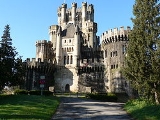
Butrón
Encyclopedia

Gatika
Gatika is a town and municipality located in the province of Biscay, in the autonomous community of Basque Country, northern Spain. As of 2009, it has 1,559 inhabitants.Probably its most famous monument is Butrón castle.-External links:*...
, in the province of Biscay, in northern Spain
Spain
Spain , officially the Kingdom of Spain languages]] under the European Charter for Regional or Minority Languages. In each of these, Spain's official name is as follows:;;;;;;), is a country and member state of the European Union located in southwestern Europe on the Iberian Peninsula...
.
It dates originally from the Middle Ages
Middle Ages
The Middle Ages is a periodization of European history from the 5th century to the 15th century. The Middle Ages follows the fall of the Western Roman Empire in 476 and precedes the Early Modern Era. It is the middle period of a three-period division of Western history: Classic, Medieval and Modern...
, although it owes its present appearance to an almost complete rebuilding begun by Francisco de Cubas (also known as Marqués de Cubas) in 1878.
The castle has a fairy-tale look about it inspired by Bavarian castle models. The present building was created as a hobby for its then owner and to create something which is visually spectacular rather than to produce something in which people could actually live. In fact it would be quite inconvenient as a home as the towers have little useful space and various parts of the castle have exterior connections which are not particularly apt for the wet Basque
Basque people
The Basques as an ethnic group, primarily inhabit an area traditionally known as the Basque Country , a region that is located around the western end of the Pyrenees on the coast of the Bay of Biscay and straddles parts of north-central Spain and south-western France.The Basques are known in the...
weather. The building is surrounded by a park which includes palms and exotic plants.
It fell into disuse and was later renovated and opened to the public. This proved to be unsuccessful and the building was closed to visitors although the grounds remained open.
In November 2005 the building was purchased by INBISA (Grupo Empresarial) for 1,629,743 euros but it remains under the general protection of Spanish law 16/1985 in respect of historic buildings in Spain.

